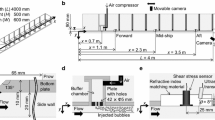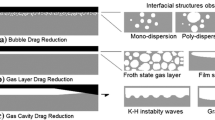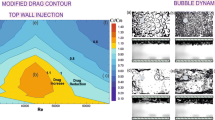Abstract
Frictional drag reduction, a technique by which bubbles are injected into the turbulent boundary layer surrounding the hull of a marine vessel, is now at the stage of practical applications. In achieving drag reduction, void waves often stand out naturally, the reason for which still remains unclear. The present study aims at an experimental characterization of void waves along a flat-bottom ship. A 100-m-long water reservoir is used in which a 4-m-long fully transparent experimental model ship, equipped with wall shear stress sensors and cameras, is towed by a train at speeds of up to 3 m/s. From measurements of the transition of the bubble distribution from random to wavy accumulated swarms downstream, the accompanying intrinsic passing frequency of void waves is examined. A 30% drag reduction rate was recorded with the appearance of void waves in the boundary layer at an average void fraction of 4%. This is much greater than the trivial inertia effect from drag reduction. To clarify the characteristics of the measured void waves, we compare the void wave frequency range to those of several flow instabilities that may occur in bubbly two-phase boundary layer flows.
Graphical abstract











Similar content being viewed by others
Abbreviations
- a :
-
Propagation speed of gravity wave, m/s
- c :
-
Averaged streamwise velocity in a bubbly flow, m/s
- C f :
-
Friction coefficient, dimensionless
- F :
-
Dimensionless constant when instability comes up, dimensionless
- f :
-
Wave-standing frequency, Hz
- f max :
-
Maximum wave-standing frequency, Hz
- f min :
-
Minimum wave-standing frequency, Hz
- f peak :
-
Peak frequency of void wave, Hz
- Fr :
-
Froude number, dimensionless
- f ref :
-
Referential frequency for normalization, Hz
- f void :
-
Frequency of void wave, Hz
- f 0 :
-
Referential frequency, Hz
- G :
-
Gain factor of drag reduction to void fraction in the boundary layer, dimensionless
- g :
-
Acceleration of gravity, m/s2
- h :
-
Characteristic length in Richardson number, dimensionless
- k :
-
Wave number, m−1
- Q g :
-
Flow rate of gas injection, m3/s
- Q g,min :
-
Minimum flow rate of gas injection, m3/s
- Q l :
-
Liquid flow rate in the boundary layer, m3/s
- \(R{e_x}\) :
-
Reynolds number on a flat plate, dimensionless
- Ri :
-
Richardson number, dimensionless
- T :
-
Time elapse in the Lagrangian frame, s
- t :
-
Elapsed time, s
- U :
-
Free stream velocity, m/s
- \({U_i}\) :
-
Velocity in fluid with suffixes i, m/s
- U main :
-
Main flow velocity (equivalent of towing speed), m/s
- \({u_y}\) :
-
Velocity distribution in the downward direction, m/s
- W :
-
Width of the model ship, m
- X :
-
Distance from the bubble injector, m
- x, y, z :
-
Cartesian coordinates of the model ship, m
- α :
-
Void fraction in a bubbly flow, dimensionless
- \({\alpha _\delta }\) :
-
Void fraction in a boundary layer, dimensionless
- δ :
-
99% thickness of a boundary layer, m
- λ :
-
Means streamwise renewal distance, m
- ν :
-
Kinematic viscosity of water, m2/s
- ρ :
-
Density of fluid, kg/m3
- \({\rho _i}\) :
-
Density of fluid with suffixes i, kg/m3
- τ w :
-
Averaged wall shear stress, Pa
- τ w0 :
-
Averaged wall shear stress in single-phase flow, Pa
References
Bagheri S, Schlatter P, Schmid P, Henningson DS (2009) Global stability of a jet in crossflow. J Fluid Mech 624:33–44
Broadbent HA, Maksik YA (1992) Analysis of periodic data using Walsh functions. Behav Res Methods Instrum Comput 24:238–247
Ceccio SL (2010) Frictional drag reduction of external flow with bubble and gas injection. Annu Rev Fluid Mech 42:183–203
Drazin PG (1958) The stability of a shear layer in an unbounded heterogeneous inviscid fluid. J Fluid Mech 4:214–224
Guin MM, Kato H, Yamaguchi H, Maeda M, Miyanaga M (1996) Reduction of skin friction by microbubbles and its relation with near-wall bubble concentration in a channel. J Mar Sci Technol 1:241–254
Helmholtz HV (1868) On discontinuous movements of fluids. Philos Mag 36:337–346,
Kelvin L (1871) Hydrokinetic solutions and observations. Philos Mag 42:362–377
Kitagawa A, Sugiyama K, Murai Y (2004) Experimental detection of bubble–bubble interactions in a wall-sliding bubble swarm. Int J Multiph Flow 30:1213–1234
Kodama Y, Kakugawa A, Takahashi T, Kawashima H (2000) Experimental study on microbubbles and their applicability to ships for skin friction reduction. Int J Heat Fluid Flow 21:582–588
Kodama Y, Hinatsu M, Hori T, Kawashima H, Takeshi H, Makino M, Ohnawa M, Sanada Y, Murai Y, Ohta S (2008) A full-scale air lubrication experiment using a large cement carrier for energy saving (result and analysis). Jpn Soc Nav Archit Ocean Eng 6:163–166 (in Japanese)
Kumagai I, Takahashi Y, Murai Y (2015) A new power-saving device for air bubble generation using a hydrofoil for reducing ship drag: theory, experiments, and applications to ships. Ocean Eng 95:183–194
McCormick ME, Bhattachayya R (1973) Drag reduction of a submersible hull by electrolysis. Nav Eng J 85:11–16
Moriguchi Y, Kato H (2002) Influence of microbubble diameter and distribution on frictional resistance reduction. J Mar Sci Technol 7:79–85
Murai Y (2014) Frictional drag reduction by bubble injection. Exp Fluids 55:1773
Murai Y, Fukuda H, Oishi Y, Kodama Y, Yamamoto F (2007) Skin friction reduction by large air bubbles in a horizontal channel flow. Int J Multiph Flow 33:147–163
Oishi Y, Tasaka Y, Murai Y, Takeda Y (2009) Frictional drag reduction by wavy advection of deformable bubbles. J Phys Conf Ser 147:012020
Park HJ, Tasaka Y, Murai Y, Oishi Y (2014) Vortical structures swept by a bubble swarm in turbulent boundary layers. Chem Eng Sci 116:486–496
Park HJ, Tasaka Y, Oishi Y, Murai Y (2015) Drag reduction promoted by repetitive bubble injection in turbulent channel flows. Int J Multiph Flow 75:12–25
Park HJ, Oishi Y, Tasaka Y, Murai Y (2016) Void waves propagating in the bubbly two-phase turbulent boundary layer beneath a flat-bottom model ship during drag reduction. Exp Fluids 57:178
Qin S, Chu N, Yao Y, Liu J, Huang B, Wu D (2017) Stream-wise distribution of skin-friction drag reduction on a flat plate with bubble injection. Phys Fluids 29:037103
Sanders WC, Winkel ES, Dowling DR, Perlin M, Ceccio SL (2006) Bubble friction drag reduction in a high-Reynolds-number flat-plate turbulent boundary layer. J Fluid Mech 552:353–380
Schbauer GB, Scramstad HK (1947) Laminar boundary layer oscillation and stability of laminar flow. J Aero Sci 14:69–78
Schlichting H (1979) Boundary-layer theory, 7th edn. McGraw-Hill Higher Education, New York
Takagi S, Matsumoto Y (2010) Surfactant effects on bubble motion and bubbly flows. Annu Rev Fluid Mech 43:615–636
Acknowledgements
This work was supported by the Fundamental Research Developing Association for Shipbuilding and Offshore (REDAS), JSPS KAKENHI Grant no. 17H01245 and Grant-in-Aid for Young Scientists (B) no. 17K14583. The authors express their appreciation for all the support. Also, the authors thank Dr. Yoshihiko Oishi at Muroran Institute of Technology and Prof. Hironori Yasukawa at Hiroshima University for their support during various parts of the towing experiments.
Author information
Authors and Affiliations
Corresponding author
Additional information
Publisher’s Note
Springer Nature remains neutral with regard to jurisdictional claims in published maps and institutional affiliations.
Rights and permissions
About this article
Cite this article
Park, H.J., Tasaka, Y. & Murai, Y. Bubbly drag reduction accompanied by void wave generation inside turbulent boundary layers. Exp Fluids 59, 166 (2018). https://doi.org/10.1007/s00348-018-2621-1
Received:
Revised:
Accepted:
Published:
DOI: https://doi.org/10.1007/s00348-018-2621-1




